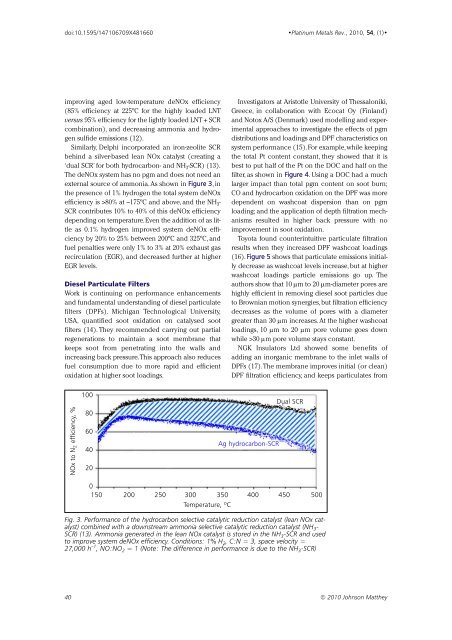Download Issue PDF - Platinum Metals Review
Download Issue PDF - Platinum Metals Review
Download Issue PDF - Platinum Metals Review
Create successful ePaper yourself
Turn your PDF publications into a flip-book with our unique Google optimized e-Paper software.
doi:10.1595/147106709X481660<br />
•<strong>Platinum</strong> <strong>Metals</strong> Rev., 2010, 54, (1)•<br />
improving aged low-temperature deNOx efficiency<br />
(85% efficiency at 225ºC for the highly loaded LNT<br />
versus 95% efficiency for the lightly loaded LNT + SCR<br />
combination), and decreasing ammonia and hydrogen<br />
sulfide emissions (12).<br />
Similarly, Delphi incorporated an iron-zeolite SCR<br />
behind a silver-based lean NOx catalyst (creating a<br />
‘dual SCR’ for both hydrocarbon- and NH 3 -SCR) (13).<br />
The deNOx system has no pgm and does not need an<br />
external source of ammonia.As shown in Figure 3,in<br />
the presence of 1% hydrogen the total system deNOx<br />
efficiency is >80% at ~175ºC and above, and the NH 3 -<br />
SCR contributes 10% to 40% of this deNOx efficiency<br />
depending on temperature.Even the addition of as little<br />
as 0.1% hydrogen improved system deNOx efficiency<br />
by 20% to 25% between 200ºC and 325ºC, and<br />
fuel penalties were only 1% to 3% at 20% exhaust gas<br />
recirculation (EGR), and decreased further at higher<br />
EGR levels.<br />
Diesel Particulate Filters<br />
Work is continuing on performance enhancements<br />
and fundamental understanding of diesel particulate<br />
filters (DPFs). Michigan Technological University,<br />
USA, quantified soot oxidation on catalysed soot<br />
filters (14). They recommended carrying out partial<br />
regenerations to maintain a soot membrane that<br />
keeps soot from penetrating into the walls and<br />
increasing back pressure.This approach also reduces<br />
fuel consumption due to more rapid and efficient<br />
oxidation at higher soot loadings.<br />
Investigators at Aristotle University of Thessaloniki,<br />
Greece, in collaboration with Ecocat Oy (Finland)<br />
and Notox A/S (Denmark) used modelling and experimental<br />
approaches to investigate the effects of pgm<br />
distributions and loadings and DPF characteristics on<br />
system performance (15).For example,while keeping<br />
the total Pt content constant, they showed that it is<br />
best to put half of the Pt on the DOC and half on the<br />
filter, as shown in Figure 4. Using a DOC had a much<br />
larger impact than total pgm content on soot burn;<br />
CO and hydrocarbon oxidation on the DPF was more<br />
dependent on washcoat dispersion than on pgm<br />
loading; and the application of depth filtration mechanisms<br />
resulted in higher back pressure with no<br />
improvement in soot oxidation.<br />
Toyota found counterintuitive particulate filtration<br />
results when they increased DPF washcoat loadings<br />
(16). Figure 5 shows that particulate emissions initially<br />
decrease as washcoat levels increase, but at higher<br />
washcoat loadings particle emissions go up. The<br />
authors show that 10 μm to 20 μm-diameter pores are<br />
highly efficient in removing diesel soot particles due<br />
to Brownian motion synergies,but filtration efficiency<br />
decreases as the volume of pores with a diameter<br />
greater than 30 μm increases.At the higher washcoat<br />
loadings, 10 μm to 20 μm pore volume goes down<br />
while >30 μm pore volume stays constant.<br />
NGK Insulators Ltd showed some benefits of<br />
adding an inorganic membrane to the inlet walls of<br />
DPFs (17).The membrane improves initial (or clean)<br />
DPF filtration efficiency, and keeps particulates from<br />
NOx to N 2 efficiency, %<br />
100<br />
80<br />
60<br />
40<br />
20<br />
Ag hydrocarbon-SCR<br />
Dual SCR<br />
0<br />
150 200 250 300 350 400 450 500<br />
Temperature, ºC<br />
Fig. 3. Performance of the hydrocarbon selective catalytic reduction catalyst (lean NOx catalyst)<br />
combined with a downstream ammonia selective catalytic reduction catalyst (NH 3 -<br />
SCR) (13). Ammonia generated in the lean NOx catalyst is stored in the NH 3 -SCR and used<br />
to improve system deNOx efficiency. Conditions: 1% H 2 , C:N = 3, space velocity =<br />
27,000 h –1 , NO:NO 2 = 1 (Note: The difference in performance is due to the NH 3 -SCR)<br />
40 © 2010 Johnson Matthey
















